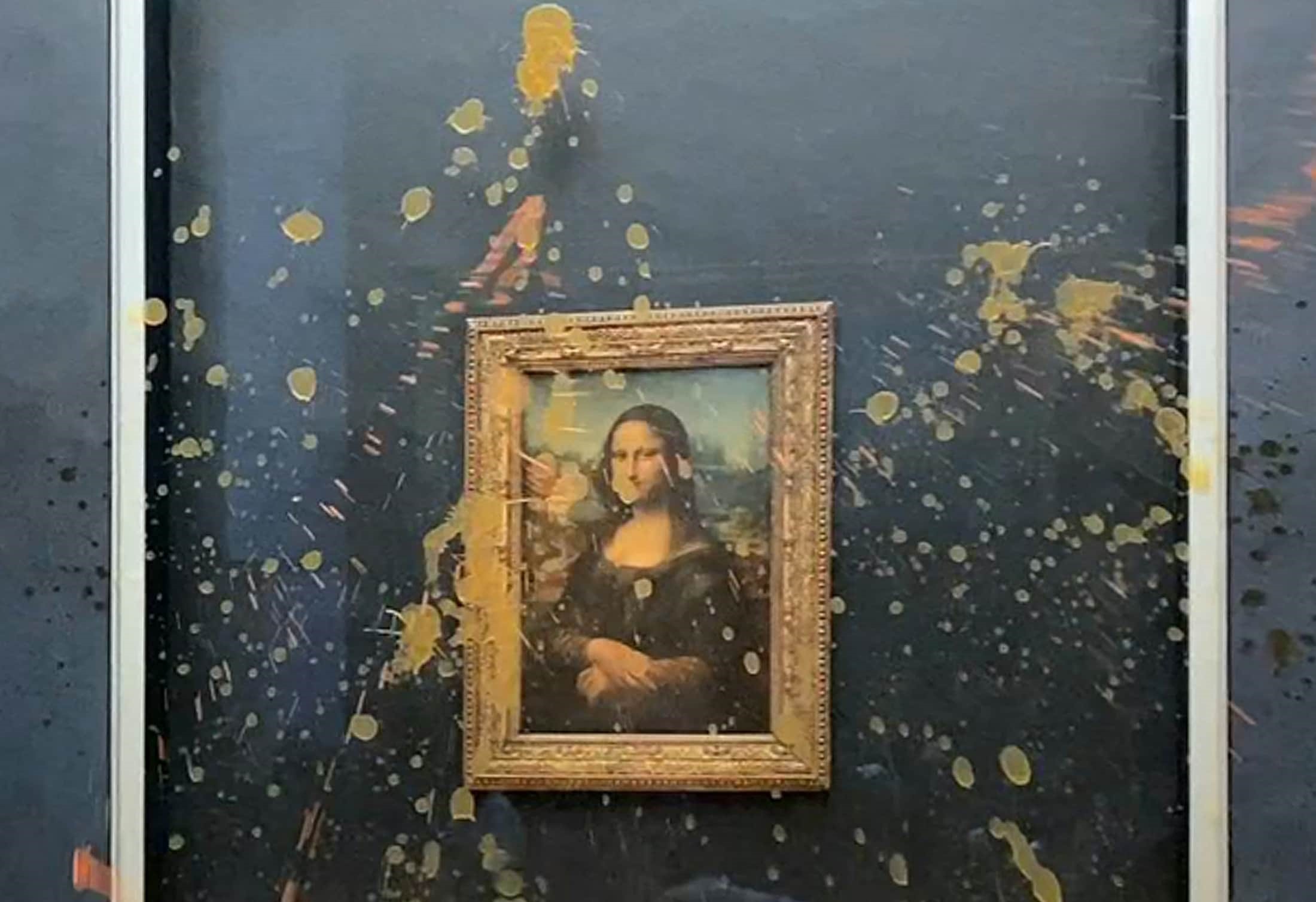Description

Disclaimer: Copyright infringement not intended.
Context
Two French activists threw soup at the Mona Lisa in the Louvre Museum as part of ongoing farmers' protests in different parts of France. The painting, protected by glass, remained undamaged.
Details
Activists and Movement
- The activists were associated with the "Riposte Alimentaire" movement.
- "Riposte Alimentaire" is part of the "A22 umbrella movement," including Just Stop Oil and Extinction Rebellion.
- The act aimed to raise awareness about issues in the agriculture sector and the environment.
Soup Throwing Campaign
- The soup throwing marked the "start of a campaign of civil resistance" for the social security of sustainable food.
- Similar tactics were employed in 2022 when Just Stop Oil activists threw soup on Vincent van Gogh's 'Sunflowers' painting in London.
Farmers' Protests in France
- French farmers protest for better remuneration, less red tape, and protection against cheap imports.
- Protests involve tractors blocking roads and setting up blockades.
- Policies targeting climate change, such as increased taxes on agricultural diesel, have affected farmers' commercial interests.
Government Response
- The French government offered to ease certain procedures and progressive end to diesel fuel taxes for farm vehicles.
- Prime Minister Gabriel Attal acknowledged the challenges faced by farmers and emphasized finding solutions.
Common Issues in Europe
- Farmers' protests in other European countries share common issues, including environmental taxes and fuel-related problems.
Related Incidents Across Europe
- In October 2022, Just Stop Oil activists threw soup on Vincent van Gogh's "Sunflowers" in London.
- Activists in Rome splashed pea soup on another Van Gogh painting, "The Sower."
- In October 2022, protesters in Potsdam flung mash at Claude Monet's "Les Meules."
- Activists in Stockholm smeared red paint on another Monet work in June 2023.
- In November 2022, Extinction Rebellion activists glued hands to Francisco Goya's paintings in Madrid.
- In April 2023, climate activists attacked a Degas wax sculpture in Washington.
- In November 2023, Just Stop Oil protesters smashed the glass cover of a Diego Velazquez painting, "The Rokeby Venus," at the National Gallery in London with hammers.

About the painting
Subject:
- The painting is officially titled "La Gioconda" in Italian or "La Joconde" in French. However, it is commonly known as the Mona Lisa.
- The presumed subject of the painting is Lisa del Giocondo, a member of the Gherardini family of Florence and the wife of wealthy silk merchant Francesco del Giocondo.
Creation:
- Created by Italian artist Leonardo da Vinci during the Italian Renaissance.
- The painting is considered an archetypal masterpiece of the Italian Renaissance, known for its enigmatic expression, composition, subtle modeling of forms, and atmospheric illusionism.
- Believed to have been painted between 1503 and 1506, but there are suggestions that Leonardo may have continued working on it as late as 1517.
- The Mona Lisa is painted in oil on a white Lombardy poplar panel.
History:
- It was acquired by King Francis I of France and has been on permanent display at the Louvre in Paris since 1797.
- The painting gained global fame in 1911 when it was stolen by Vincenzo Peruggia, an Italian who believed it should belong to Italy. The theft and subsequent recovery generated widespread publicity.
- The Mona Lisa has survived theft attempts, vandalism, and wartime relocation during World War II.
Description:
- The painting depicts Lisa del Giocondo in a half-length portrait, sitting in an imaginary landscape with a mysterious smile.
- Leonardo used a technique called sfumato, which involves not drawing outlines, to create a soft and realistic appearance.
- The sitter's three-quarter profile and the use of aerial perspective were innovative for the time.
Model Controversy:
- While traditionally considered to depict Lisa del Giocondo, some scholars have proposed alternative views, suggesting other potential models for the painting.
- Some art historians argue that Lisa del Giocondo may have been the subject of a different portrait, and there might be multiple paintings referred to as the Mona Lisa by Vasari.
Modern Analysis and Conservation:
- In the early 21st century, scientist Pascal Cotte suggested the presence of a hidden portrait beneath the surface of the painting, though this theory has been debated.
- The Mona Lisa has undergone conservation treatments over the centuries, including cleanings, revarnishing, and touch-ups. However, it has never been fully restored.
About Leonardo di ser Piero da Vinci
- An Italian polymath of the High Renaissance
- Active as a painter, draughtsman, engineer, scientist, theorist, sculptor, and architect
- Initially renowned for his achievements as a painter
Notable Accomplishments and Contributions:
- Known for his notebooks, containing drawings and notes on subjects such as anatomy, astronomy, botany, cartography, painting, and paleontology.
- Widely regarded as a genius who epitomized the Renaissance humanist ideal.
- His collective works are considered a contribution to later generations of artists matched only by Michelangelo
- Credited as the founder of the High Renaissance.
- Identified as one of the greatest painters in the history of art.
- Created influential paintings, including his magnum opus, the Mona Lisa.
- His Vitruvian Man drawing is regarded as a cultural icon.
- The Last Supper is the most reproduced religious painting of all time.
- The painting Salvator Mundi, attributed to Leonardo, was sold at auction for US$450.3 million in 2017, setting a new record for the most expensive painting ever sold at public auction.

Technological Ingenuity and Inventions:
- Conceptualized flying machines, armored fighting vehicle, concentrated solar power, and a ratio machine.
- Some smaller inventions entered the world of manufacturing, such as an automated bobbin winder and a machine for testing the tensile strength of wire.
- Made substantial discoveries in anatomy, civil engineering, hydrodynamics, geology, optics, and tribology.
- However, many of his designs were not constructed or feasible during his lifetime due to the early stage of scientific approaches to metallurgy and engineering during the Renaissance.
- Made substantial discoveries in anatomy, civil engineering, hydrodynamics, geology, optics, and tribology.
- However, did not publish his findings, and they had little to no direct influence on subsequent science.
|
PRACTICE QUESTION
Q. Apart from his artistic achievements, Leonardo da Vinci made significant contributions to various fields. Which of the following scientific areas did he extensively explore?
A) Quantum Physics
B) Organic Chemistry
C) Human Anatomy
D) Astrophysics
Answer: C)
|







